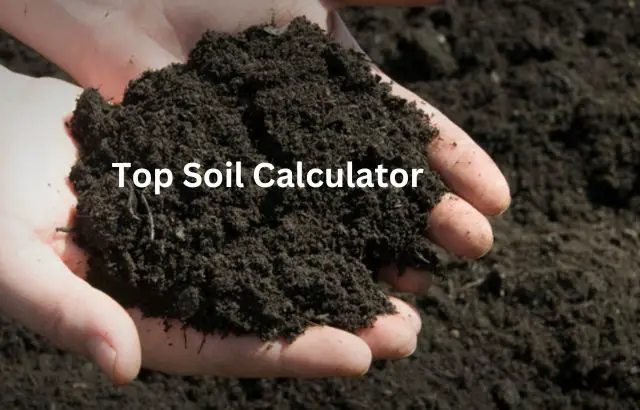Top Soil Calculator | Calculate How Much Soil You Need
Articles, products, and services offered on this site are for informational purposes only. We are part of the Amazon Services LLC Associates Program, an affiliate advertising program. Amazon.com is compensated for sales resulting from links on our website.
Please review our disclaimer before acting based on anything you read or see.
These days, it’s critical to comprehend the scale of your landscaping job and what you want to achieve. A fresh garden or raised bed typically requires a few inches of dirt to fill. The Top Soil Calculator will be of great use to you if your goal is to prevent errors.
You may calculate the ideal dirt needed for your project with the topsoil calculator. This minimizes waste and costs you less while ensuring you have the proper coverage and depth.
One of the most often asked questions by gardeners wanting to purchase dirt is how much topsoil I need. You need to know how much you need for your project to avoid spending more money and ending up with a surplus of topsoil. Alternatively, you could require a second, more expensive topsoil delivery, hindering your gardening endeavor. Come along as we guide you on the Top Soil Calculator below.
What is the Top Soil Calculator?
The soil calculator is a pre-programmed web application that accepts the data required to determine how much dirt should fill in a certain area. To achieve this, the soil volume is calculated. To do this, increase the garden bed’s length, breadth, and depth by the garden’s dimensions. Next, divide that sum by the number of cubic feet of dirt in a particular soil bag.
Top Soil Calculator
Types of Top Soil
You need to ensure that the dirt you choose is the right kind for the project you’re conducting since there are several sorts of topsoil available for gardeners and landscapers. Major soil types include:
Chalky terrain
Chalk-based soil is notoriously difficult to deal with. For a gardener attempting to produce the perfect lawn or grow veggies, the problems of having this soil type might be rather daunting.
Chalk is a rocky soil with plenty of open space below the surface that is prone to drying up and losing a lot of water and nutrients. Due to this quality, gardeners who use this soil must be ready to water and fertilize more regularly. This soil is often discovered near chalk cliffs along the UK’s coast.
Clay soil
For soil to be categorized as clay, it must contain above 25% clay, making it heavy and often challenging to deal with. Small, separated particles make up the soil with a clay foundation. According to this, the soil retains a lot of water, drains gradually, and takes a while to warm up in the spring and summer.
Since of its high density, it might be difficult for gardeners and landscapers to work in the winter because the ground is prone to waterlog, which can impede the development of your garden grass. This soil is often found on the bottom of ponds and lakes and in the floodplains of rivers and streams.
Peatland
According to the International Peatland Society, peat soil is the top organic layer of soil. It is mostly made up of organic materials that have partly degraded from plant stuff. These often build up in saturated, oxygen-deprived environments, are highly acidic, and are nutritionally deficient.
Peat soil often has a dark brown or black hue and is soft, readily crushed, and rich in organic matter. Peatlands and overall topsoil are both popular locations for this kind of soil.
Muddy soil
One of the healthiest soil for plants to flourish on is loam. It looks rich and dark brown, feels wet, and often congeals into a crumbly ball. Since the combination often contains 20% clay, 40% silt, and 40% sand, it slightly mitigates the drawbacks of each kind of soil.
Despite being ideal for general gardening, this soil may be vulnerable to erosion. Additionally, if the soil’s pH balance is off, it may have unfavorable consequences. It is rare for this soil to exist in the wild.
Why you need a Top Soil Calculator
Use the calculator below to determine how much topsoil you’ll need.
Your final estimates will be more precise the more exactly you measure the width, height, and depth. Please remember that your final figure will be an approximation since the bulk density of various topsoil materials differs.
How much Topsoil Do You Need?
Directly measure the area you want to cover and multiply the results by the depth needed to get how much topsoil you’ll need. The easiest method is to measure in meters since you will know how many cubic meters of topsoil you need.
By reducing the volume in a bag after you know the value in cubic meters, you may determine how many bulk bags are required. When evaluating various items, remember that bulk bags come in various sizes.
How much is a Yard of Dirt?
The cost of a bagged yard of soil varies according to its thickness, fertility, and water and clay content. Additionally, it depends on the kind of soil you get. Although purchasing loose dirt is less expensive than buying it in bulk bags, it isn’t easy to carry since the soil’s moisture level fluctuates. Because of this, you may anticipate paying $10 to $15 per yard of loose soil.
Then again, this is for a common cubic yard at a shallow depth (3 inches). The cost will undoubtedly increase if you wish to go further. To give you a better picture of what to anticipate:
- Anticipate $15–$20 per cubic yard at depths of 3–6 inches.
- Prepare to spend between $40 and $45 per cubic yard for 6 to 9 inches.
- Anticipate at least $55 per cubic yard for 9 to 12 inches (or more).
How to Estimate Soil in Tons
Accurately determine the area you want to cover and multiply the results by the depth needed to get how much topsoil you’ll need. The easiest method is to measure in meters since you will know how many cubic meters of topsoil you need.
By dividing by the capacity in a bag, you may determine the number of bulk bags required after you know the value in cubic meters. When evaluating various items, remember that bulk bags come in various sizes.
Frequently Asked Questions
How much will a yard of topsoil cover?
A dirt yard may cover 100 square feet of soil with a 3-inch depth or 324 square feet with a 1-inch depth.
How much topsoil should I use?
A new garden or raised bed typically needs 8 inches of dirt to fill. You will want 4-6 inches of topsoil if you plan to add more to your lawn to achieve the desired level of health.
How many yards are in a ton of topsoil?
A ton of topsoil will typically cover 0.63 cubic meters, 22 cubic feet, or 0.81 cubic yards.
How much is a dump truck topsoil?
For a normal 10 to 15-yard load delivered, a dump truck load of dirt costs $150 to $500 on average. Prices vary according to the quantity purchased, the topsoil’s local cost, and the transporting distance. Spreading and installation are not included in the prices.
How many 40lb bags of topsoil in a yard?
There are 27 40-pound bags of dirt in a cubic yard because 27 cubic feet in a square yard and a cubic foot of topsoil weigh roughly 40 pounds.
How many tons are 6 yards?
1.4 times six cubic yards of gravel is 8.4 tons.
Expert Opinion
The topsoil calculator, which uses your dimensions to determine how many tons (or bags) of topsoil you’ll need, is a great tool. This will enable you to fill the available space. Thus, it tends to be indispensable.



Comments are closed.